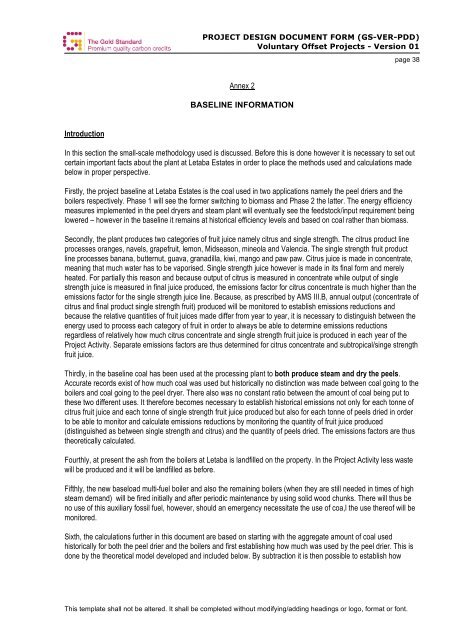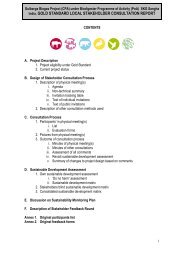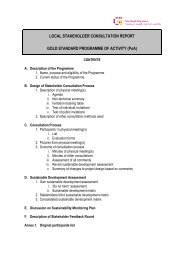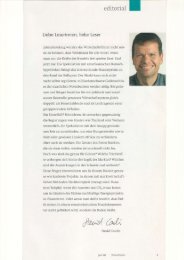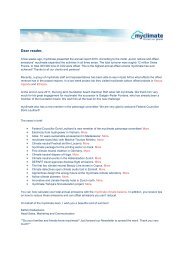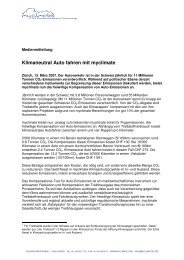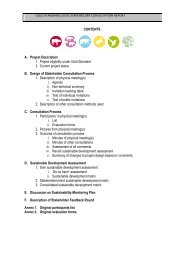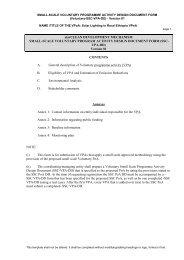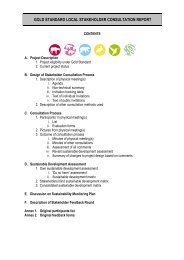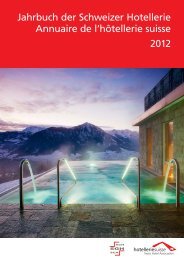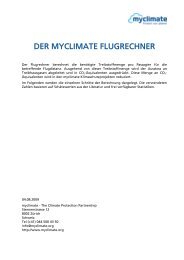Letaba Biomass to Energy PDD - MyClimate
Letaba Biomass to Energy PDD - MyClimate
Letaba Biomass to Energy PDD - MyClimate
You also want an ePaper? Increase the reach of your titles
YUMPU automatically turns print PDFs into web optimized ePapers that Google loves.
Introduction<br />
PROJECT DESIGN DOCUMENT FORM (GS-VER-<strong>PDD</strong>)<br />
Voluntary Offset Projects - Version 01<br />
Annex 2<br />
BASELINE INFORMATION<br />
This template shall not be altered. It shall be completed without modifying/adding headings or logo, format or font.<br />
page 38<br />
In this section the small-scale methodology used is discussed. Before this is done however it is necessary <strong>to</strong> set out<br />
certain important facts about the plant at <strong>Letaba</strong> Estates in order <strong>to</strong> place the methods used and calculations made<br />
below in proper perspective.<br />
Firstly, the project baseline at <strong>Letaba</strong> Estates is the coal used in two applications namely the peel driers and the<br />
boilers respectively. Phase 1 will see the former switching <strong>to</strong> biomass and Phase 2 the latter. The energy efficiency<br />
measures implemented in the peel dryers and steam plant will eventually see the feeds<strong>to</strong>ck/input requirement being<br />
lowered – however in the baseline it remains at his<strong>to</strong>rical efficiency levels and based on coal rather than biomass.<br />
Secondly, the plant produces two categories of fruit juice namely citrus and single strength. The citrus product line<br />
processes oranges, navels, grapefruit, lemon, Midseason, mineola and Valencia. The single strength fruit product<br />
line processes banana, butternut, guava, granadilla, kiwi, mango and paw paw. Citrus juice is made in concentrate,<br />
meaning that much water has <strong>to</strong> be vaporised. Single strength juice however is made in its final form and merely<br />
heated. For partially this reason and because output of citrus is measured in concentrate while output of single<br />
strength juice is measured in final juice produced, the emissions fac<strong>to</strong>r for citrus concentrate is much higher than the<br />
emissions fac<strong>to</strong>r for the single strength juice line. Because, as prescribed by AMS III.B, annual output (concentrate of<br />
citrus and final product single strength fruit) produced will be moni<strong>to</strong>red <strong>to</strong> establish emissions reductions and<br />
because the relative quantities of fruit juices made differ from year <strong>to</strong> year, it is necessary <strong>to</strong> distinguish between the<br />
energy used <strong>to</strong> process each category of fruit in order <strong>to</strong> always be able <strong>to</strong> determine emissions reductions<br />
regardless of relatively how much citrus concentrate and single strength fruit juice is produced in each year of the<br />
Project Activity. Separate emissions fac<strong>to</strong>rs are thus determined for citrus concentrate and subtropical/singe strength<br />
fruit juice.<br />
Thirdly, in the baseline coal has been used at the processing plant <strong>to</strong> both produce steam and dry the peels.<br />
Accurate records exist of how much coal was used but his<strong>to</strong>rically no distinction was made between coal going <strong>to</strong> the<br />
boilers and coal going <strong>to</strong> the peel dryer. There also was no constant ratio between the amount of coal being put <strong>to</strong><br />
these two different uses. It therefore becomes necessary <strong>to</strong> establish his<strong>to</strong>rical emissions not only for each <strong>to</strong>nne of<br />
citrus fruit juice and each <strong>to</strong>nne of single strength fruit juice produced but also for each <strong>to</strong>nne of peels dried in order<br />
<strong>to</strong> be able <strong>to</strong> moni<strong>to</strong>r and calculate emissions reductions by moni<strong>to</strong>ring the quantity of fruit juice produced<br />
(distinguished as between single strength and citrus) and the quantity of peels dried. The emissions fac<strong>to</strong>rs are thus<br />
theoretically calculated.<br />
Fourthly, at present the ash from the boilers at <strong>Letaba</strong> is landfilled on the property. In the Project Activity less waste<br />
will be produced and it will be landfilled as before.<br />
Fifthly, the new baseload multi-fuel boiler and also the remaining boilers (when they are still needed in times of high<br />
steam demand) will be fired initially and after periodic maintenance by using solid wood chunks. There will thus be<br />
no use of this auxiliary fossil fuel, however, should an emergency necessitate the use of coa,l the use thereof will be<br />
moni<strong>to</strong>red.<br />
Sixth, the calculations further in this document are based on starting with the aggregate amount of coal used<br />
his<strong>to</strong>rically for both the peel drier and the boilers and first establishing how much was used by the peel drier. This is<br />
done by the theoretical model developed and included below. By subtraction it is then possible <strong>to</strong> establish how


